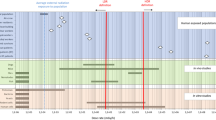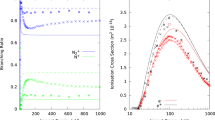Abstract
It is always useful to predict the result of an experiment without having to carry it out. In cyclic activation analysis where the signal-to-noise ratio for the detection of short-lived nuclides in a given matrix is particularly sensitive to the value of the timing parameters, determination of the best conditions for the detection of a nuclide of interest, without resort to preliminary experiments, is most helpful. Simulation and optimisation of a gamma-ray spectrum is derived for a sample irradiated in cyclic mode. The simulation includes consideration of photopeak, Compton continuum, single and double escape peaks and bremsstrahlung. The simulation output forms the input to the signal-to-noise ratio optimisation routine. Consequently the sensitivities, and detection limits for the isotopes of interest can be deduced from the optimised spectrum. Interference from other gamma-lines is identified, if applicable. In addition, a graphical output of the simulated spectrum and a listing of the optimised activation parameters, detection limits and sensitivites are produced. The programme has been extended to include simulation of conventionally neutron activated samples. Examples for standard reference materials are given as illustrations, together with measured spectra.
Similar content being viewed by others
References
N. M. SPYROU, J. Radioanal. Chem., 61 (1981) 211.
N. M. SPYROU, Application of cyclic activation to ‘in vivo’ elemental analysis, Proc. 5th Int. Conf. on Nuclear Methods in Environmental and Energy Research, Puerto Rico, CONF-840408 (DE84017348), 1984, p. 715.
L. ZIKOVSKY, E. A. SCHWEIKERT, User of Simulated Gamma Ray Spectra in Activation Analysis, NIM. 155, 1978, p. 279.
V. P. GUINN, J. C. LESLIE, L. NAKAZAWA, Performance of the updated INAA advance prediction computer program. Proc. 6th Conf. on Modern Trends in Activation Analysis, Toronto, 1981.
D. L. ANDERSON, M. P. FAIZEY, W. H. ZOLLER, W. B. WALTERS, G. E. GORDON, R. M. LINDSTROM, J. Radioanal. Chem., 63 (1981) 97.
D. V. LAW, SPECTRE: A computer program to simulate gamma ray spectra of neutron irradiated materials, AERE-R-11040, 1984.
H. W. KOCH, J. W. MOTZ, Rev. Mod. Phys., 31 (1959) No. 4, 920.
K. A. WRIGHT, J. G. TRUMP, J. Appl. Phys., 33 (1962) 687.
E. P. BLIZARD, L. S. ABBOT (Eds), Shielding, Vol. 3, Pt. B of Reactor Handbook, 2nd ed. Interscience Publishers, Inc. New York, 1963.
J. JOSEPH, F. ROHRLICH, Rev. Mod. Phys., 30 (1958) 354.
W. EARDER, E. EGAN, T. D. MACMAHON, Talanta, 25 (1978) 21.
A. EGAN, Short-lived isotopes and instrumental neutron activation techniques for elemental concentrations in environmental samples, PhD Thesis, University of Surrey, 1977.
Author information
Authors and Affiliations
Rights and permissions
About this article
Cite this article
Al-Mugrabi, M.A., Spyrou, N.M. The use of simulation for the optimisation of the signal-to-noise ratio in cyclic activation analysis. Journal of Radioanalytical and Nuclear Chemistry, Articles 110, 67–77 (1987). https://doi.org/10.1007/BF02055011
Received:
Issue Date:
DOI: https://doi.org/10.1007/BF02055011




